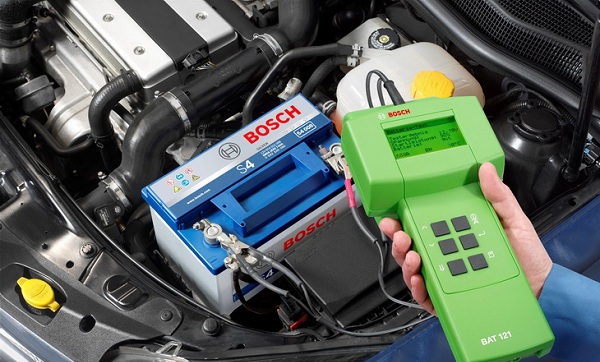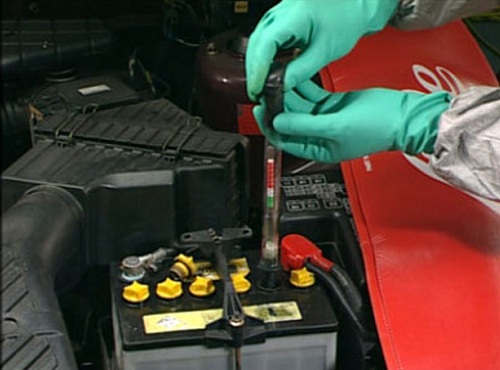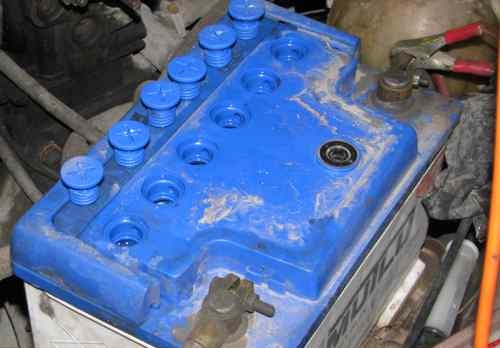Determine and check the operating time of the automotive battery
Any car detail has its own shelf life, determined by the manufacturer initially. The vitality of such an essential element as a battery is on average without much maintenance about 4-5 years. But this time is far from definitely. Depending on numerous factors: a specific model, machine brand, level of operation - the service range can be much increased or, on the contrary, will be reduced.
Let's deal with what exactly affects.
Degree of charge
The minimum interval of the operation of the battery should be, according to experts, at least three and a half years. Find out first of all how powerful. Perhaps the battery spends much more energy than is supposed in a technical passport. Either, on the contrary, is often in a discharged state. It must be remembered that a number of such discharges leads to different violations in further work.
Before you calculate how much your battery has been worked, check if it was simply discharged. Sometimes to complete the restoration of forces. In this case, you need to create conditions in which the charging current will be equal to 18-24 volts to speed up the process.
Numerous electronic devices in your car, such as an audio system, telephone and others also use the battery generosity. Short air-conditioned trips consume more energy than you have time to generate. But at long distances, the battery holds the balance.
One more consumers of energy are, for example, on-board computer, security system, door opening system. They continue to act, even when you are not: at night in the garage, in the "sleep mode". You can find the culprit by turning off the minus terminal.

There are adapters, their function is to determine the weak currents. For automotive devices, less than 50 milliam perm can be revealed at about an hour. Systems that do not switch to "sleep mode" consume a current of hundreds of millions. When the battery capacity is 54 amps per hour, it is easy to predict how many hours you will need a battery.
Corrosion
All batteries producers lead to it. This is an example, antimunct technologies. Antimony added to alloy attracted water expenses accordingly. Observe the optimal ratio between water consumption and corrosion resistance is always difficult.
Temperature mode
Weather conditions, especially frost, negatively affect batteries. This is due to the viscosity of the electrolyte, which is drawn by an increase in the resistance to the passage of charge. The consequences of such processes become:
- Lowering the tank.
- Defrosting electrodes.
- Sowing electrodes.
- Cutting the period of duration of work.
- Deformation of the case.
- Full failure.

What happens when high temperatures?
- High evaporation of water.
- Next to corrosion.
- When stored, the possibility of self-discharge increases.
- Not excluded reload.
- As a result, compressing battery life.
Any voltage fluctuations have a significant impact on. For example, in summer, with a high charging level, a reload may occur. Its level exceeds 14.5 V. If the charging voltage is less than 13.8 V, then it turns out an underwriter. And the ability to work the battery is also reduced.
In winter, the discharge of the battery is allowed to 25%, and in summer to 50%. In winter, it is impossible to achieve a larger percent so that the electrolyte is not frozen.
If the battery is used for a long time during discharge in 60-70%, then its performance is rapidly decreasing.
Short circuit
Instant electrical shock completely displays the battery. Envelopes-separators are applied to help, they share plates. Short circuit can be the result of marriage in new models. If there is a guarantee, it must be changed to the working one.
For the old models, the closure is the cause of resignation. With the plates of the battery, the paste is powered, accumulating accumulation occurs, which largely affects performance and reduces the battery life of the car. Related charged plates are closed. Pastonamazk technologies are used to prevent creep of active paste.
To identify a short circuit is not difficult to constantly reduce the level of electrolyte, despite the optimal charge in the battery. And after complete battery charging, fast loss of tank occurs. The damaged battery immediately increases the temperature. The voltage and density of the electrolyte remain at the same level during the charge, but decrease with the termination of the charge.
Sulfation
The state of the battery sulfate is caused by the presence of electrodes that do not receive charging voltage, although it is passed enough.

It is characteristic of this process a sharp increase in temperature, slow increase in the density of the electrolyte. As soon as the battery is included for charging, gases are released. Provocate the sulfate of the phenomenon of constant short-term battery, work at very high temperatures. Or, if often is in the discharged state, and also applied contaminated electrolyte.
Unfortunately, it will not be possible to fully correct the situation at sulfation. If there were no discontinuities of the electrodes, you can try in charge for a long time, more than 24 hours. Until you see that 5-6 hours voltage and electrolyte density are kept at one level.
What to expect from the battery life of the car
The ratio of various factors, processes and irritants determine the operational properties of the battery. Cars, which are intensively used, for example, "taxi" are the lowest. Wearing electrodes occurs after a year and a half. But there are happy drivers who have the ability to drive a car with one battery for more than 6 years. With proper care, the battery life of the car increases.
Video about what factors affect the service life of the AKB:
For this it is necessary to periodically check the voltage on terminals At the time of work and recreation of the battery. Once or two per month monitor the level of electrolyte and maintain it with the addition of distilled water. Do not allow discharges more than 50-60%. Not always the indicator corresponds to the real degree of charge. Even with the green light, the percentage is above 60. After checking the charge, you ensure the reliability of the battery operation and thereby extend the service life.










